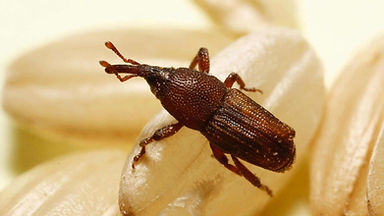Neuroparasitology Research
Neuroparasitology is an emerging scientific field dedicated to studying parasites that can control the nervous system and manipulate the behavior of their hosts. Fungal parasites do this to improve their chances of spreading infectious spores to new hosts. To understand how certain species of these fungi are able to "hack" the brains of beetles, our lab uses a combination of model organisms like C. elegans, yeast, and bacteria to identify the molecular targets of behavioral effectors. Once we have identified the neurological pathways involved, we then test for behavior effects in the natural beetle hosts! By using this approach, we aim to discover safer insecticidal compounds to combat agricultural pests.
Agricultural Weevil Pests
Weevils are a type of beetle belonging to the superfamily Curculionoidea, and are known for their long, cute snouts. Unfortunately, some weevils cause large amounts of damage to agricultural crops, particularly during the storage of grains. The Rice and Maize Weevils from the genus Sitophilus are particularly problematic in the U.S., and can destroy between 5% - 10% of grain stores. This amounts to a loss of $1.25 - $2.5 billion every year! The Red Palm Weevil (Rhynchophorus ferrugineus) is another weevil pest that is invasive in the U.S., meaning it is not native to the environment. Invasive species can be particularly problematic because they lack natural predators to keep them in check, allowing them to spread uncontrollably. Despite their name, the Red Palm Weevil not only infects coconut, oil, and sago palms, but are also a threat to dates in the U.S. as well. With such an impact on the nation's food stores, it no wonder that many scientists have made it their goal to come up with creative solutions to this problem.



Zombie fungi as a solution!
Zombie fungi from the genus Ophiocordyceps are well known thanks to popular sci-fi media like The Last of Us. These amazing fungi are able to infect insects and manipulate their behavior to help spread infectious fungal spores to new hosts. To do so, these fungi secrete hundreds of uncharacterized biomolecules that can affect the insect nervous system, making them an untapped resource for the discovery of natural pesticides!
The mission of our lab is to discover how each of the unique biomolecules made by beetle-infecting zombie fungi affects the nervous system of invertebrates, and to use this information to help fight off agricultural pests in a safe and responsible way. This includes protecting other natural insects in the environment, like pollinators. But working with these fungi in the lab can be difficult, so our lab uses other organisms like C. elegans to help us unravel the neurotoxic mechanisms.


Using C. elegans to study the nervous system
C. elegans (short for Caenorhabditis elegans) is a model organism frequently used for studying how chemicals affect the nervous system. These worms, also called nematodes, have a simple nervous system of only 302 neurons, all of which have been completely mapped into what we call a connectome. This map offers a clear framework for observing neurotoxic effects of biomolecules like those produced by Ophiocordyceps species.
The transparent body of nematodes also allows researchers like us to visualize neuronal changes in real time using fluorescent markers. While you might think worms like these are very simple creatures, C. elegans shares many conserved molecular pathways with other animals, making their reactions relevant to insect neurobiology. Because C. elegans is easy-to-grow, cost-effective, and genetically tractable, we can use them as initial screening tools before exploring the impact of new compounds in the more difficult to work with insect systems.



Zombie Soldier Beetles and Population Genetics
Zombie goldenrod soldier beetles (Chauliognathus pensylvanicus) are beetles native to North American and often found on late-summer flowers like goldenrod, where they feed on pollen and nectar. These beetles can fall victim to another type of zombie fungus called Eryniopsis lampyridarum, which manipulates their behavior before killing them. Prior to death, this fungus causes infected beetles to climb up nearby flowers, clamp onto the plant with its mandibles, and raise its wings in a dramatic pose. These behaviors help elevate the host and remove the wings as obstacles for the spread of new fungal spores.
Most zombie fungi are highly specialized and limited to small geographic areas, often infecting specific hosts in narrow habitats. However, the geographical range of E. lampyridarum spans several states across the East and Midwest. This wide distribution makes it an excellent system for studying population genetics in zombie fungi, allowing researchers to explore how genetic diversity, dispersal, and adaptation occur on a larger scale! You can contribute to this research directly by documenting the location of infected beetles on iNaturalist through the community science project page ZomBeetles.



